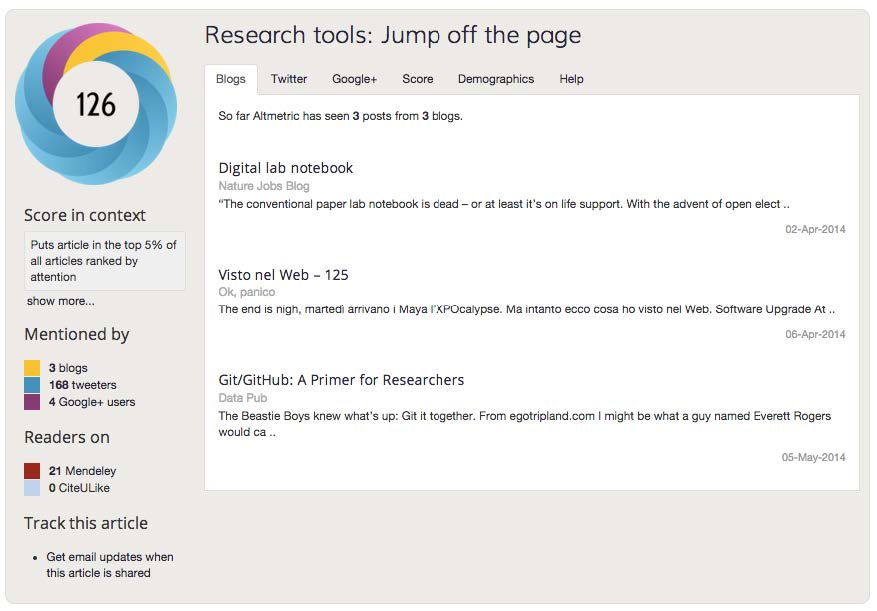Day 4: Understand Altmetrics
 "Altmetrics is the creation and study of new metrics based on the Social Web for analyzing, and informing scholarship." (http://altmetrics.org/about/)
"Altmetrics is the creation and study of new metrics based on the Social Web for analyzing, and informing scholarship." (http://altmetrics.org/about/)
Alternative metrics, or altmetrics, involve evidence of discussion happening online, including links, shares, views, and downloads in social media, blogs, and other venues, which can demonstrate popular or societal impact in areas such as education, public policy, etc.
Altmetrics are intended to complement, not replace, citations.
- In today's challenge, you will learn about the altmetric response to your scholarship by using a free tool that counts and colorfully displays altmetric activity for articles.
- There are three steps:
- Install the Altmetric bookmarklet
- Try it with your articles
- Read the Altmetric.com report
Step 1: Install Altmetric bookmarklet
1. First, install the Altmetric.com browser bookmarklet (visit this page and drag the “Altmetric It!” button into your browser menu bar - works with Chrome, Firefox, and Safari).

Step 2: Try with your article
2. Then, find your article on the publisher’s website and click the “Altmetric it!” button. The altmetrics for your article will appear in the upper right-hand side of your browser window, in a pop-up box similar to the one below.

Note: the article must have a DOI, PubMed ID, ArXiv ID, or Handle in order for the bookmarklet to work. If the article does have one of these, but you're still having trouble, try refreshing the page, highlighting the DOI/PubMed ID/etc. and then clicking the bookmarklet.
Step 3: Read the Altmetric.com report
3. Next, follow the “Click for more details” link in the Altmetric pop-up. You’ll be taken to a detailed report of your metrics and the underlying qualitative data.
This report (seen below) shows you not only the numbers, but also lets you read the individual blogs, policy documents, newspapers, and other online outlets that mention your article. The donut visualization at the top-left of the report includes a single, weighted score that attempts to sum up the attention that your work has received. Below the visualization is contextual information that shows you how the article’s metrics compare to those of articles published in the same year, journal, and so on.

At the bottom left-hand corner of the page, you can sign up to receive notifications whenever someone mentions your article online. The only drawback of Altmetric.com’s notification emails is that you have to sign up for a new notification for each article. This can cause inbox mayhem if you are tracking many publications.
----------
For further information about Altmetrics, see the Emory Libraries' Publication and Impact Analysis Guide.
--------
Information on this page was adapted from:
Duquesne University Library 5-Day Impact Challenge research guide
Konkiel, Stacy. (2014). 30-Day Impact Challenge: the ultimate guide to raising the profile of your research. http://blog.impactstory.org/wp-content/uploads/2015/01/impact_challenge_ebook_links.pdf
